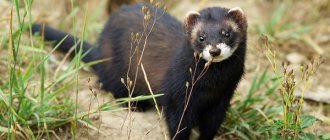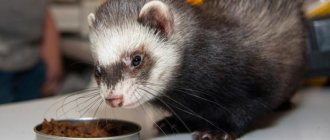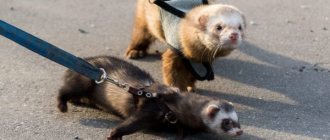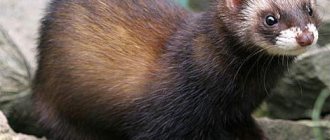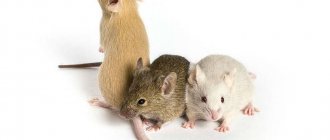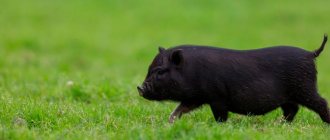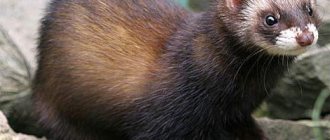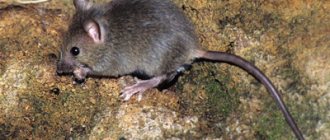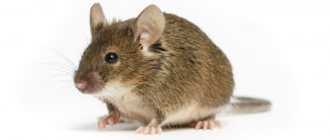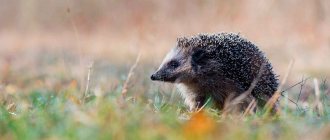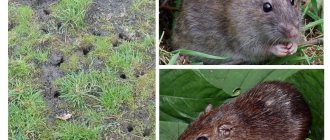Livestock » Ferrets
0
3365
Article rating
Kira Stoletova
Ferrets are nimble animals from the mustelidae family. With their cute faces and lively character, they can make you fall in love at first sight. Before you get this unusual animal, you need to figure out what breeds of ferrets exist and how they differ from each other.
Colors and breeds of decorative ferrets
Colors of decorative ferrets
There is no single classification regarding the colors of ferrets.
In each country, ferrets are given their own names. We most often use mixed names of American and Russian standards. Domestic ferret puppies are born blind and helpless; their mother feeds them milk.
• Sable ferrets have black or brown guard hairs and a cream, white or yellowish undercoat. The muzzle is decorated with a clear mask, the nose and eyes are dark brown or black. • Black sable ferrets have darker colors than sable ferrets. • The red-eyed albino ferret has white fur without any pigmentation. • A white ferret with dark eyes is white or light cream in color, with dark eyes and a pink nose. • The champagne ferret has light brown guard hairs and a white or cream undercoat without yellowing. The nose of a champagne-colored ferret is light. • The brown ferret has bright brown guard hairs with redness and a white or golden undercoat. The nose may be beige or pink. • The chocolate ferret has a white or yellow undercoat and chocolate-colored guard hairs. • The black ferret has a white or golden undercoat with black guard hairs. The nose is mottled or dark.
Also available in a variety of designs. For example, Siamese ferrets have darker legs and tails. Roan ferrets have approximately equal amounts of white and colored hair.
In addition, the location of the white areas is taken into account. Panda ferrets have a white head and neck, may have “socks” on their paws, and the tip of their tail is also white. Blaze ferrets have a white head stripe, white toes, and a white tail tip. Mitts ferrets have white toes and a facial mask that is the same color as their overall coat.
If you find an error, please select a piece of text and press Ctrl+Enter.
Interesting facts about ferrets:
- In one of his paintings called “Lady with an Ermine,” Leonardo da Vinci depicted a ferret, not an ermine. Since then, the fashion for keeping ferrets in the house along with cats arose.
- If the ferret is in a good mood, he will constantly wag his tail. However, if he is wary, then this very tail unravels and is followed by a displeased hiss. In this mood, it is better not to touch the ferret, because he may bite or even attack.
- The well-known phraseology “sleeps like a log” fits the description of ferrets. Some ferrets can sleep for several days without waking up. It is almost impossible to wake them up, which is why many owners get scared, although this is normal for their life.
Steppe ferret
These are nocturnal predators, which are rightfully considered the largest of the entire family. Their body length can reach 60 cm. The average weight of the animal is 0.6 kg. In appearance, the animal differs from its forest counterpart. The steppe polecat has fur with tall, sparse, light-colored hair. The thick light undergrowth is clearly visible under it. The paws and tip of the tail may be dark, the muzzle also has dark spots and looks like a mask.
Pregnancy lasts just over one and a half months. A newborn cub weighs no more than ten grams, but grows quickly. Already in the eighth week of life, young animals are able to hunt.
The steppe ferret is very fertile
What does a wood ferret look like?
The ferret is small in size and in appearance is a typical representative of its family.
Constitution
The body is elongated, flexible, squat with short but strong legs. This structure allows it to silently sneak up on its prey. The ferret has an elongated neck, a small oval head, an elongated muzzle, slightly flattened towards the nose.
Basic parameters of the forest ferret:
Color
The animals have long fur, which can reach 6 cm, and different colors - from dark gray to black. However, in the wild there are also individuals with brown, reddish, yellow colors, and there are also albino representatives.
Color is never monotonous. Thus, the tail, belly and paws are always darker than the body, and on the muzzle there is a white mask, which is a characteristic feature of a ferret.
Structural features
The main structural features of the animal include:
- the small head smoothly transitions into a flexible and elongated neck;
- the ears are small, low, with a wide base;
- the eyes are brown, shiny, bead-like;
- the paws are short and thick, even in the largest individuals the length of the hind legs is only 6-8 cm;
- the paws have 5 toes, between which there are membranes;
- the forest ferret has 28-30 teeth, of which 4 canines, 12 premolars, 12-14 incisors;
- next to the tail of the animal there are special glands, which, in case of danger, secrete a secretion with a fetid odor.
Honorik
Honorik is an artificially produced hybrid of a ferret (bred by crossing the steppe and forest ferrets) and the European mink. Honoriki rarely appear in the wild in areas where the ranges of these 3 species overlap. Honoriki are larger than their parents and inherit their traits equally. Outwardly, the animals resemble a mink, and their black, shiny guard hair with a thick brown underfur is very similar to sable fur. From ferrets, the animals got large ears with a light border around the edges. Honoriki, like minks, are excellent swimmers, and from trochees they adopted the ability to dig holes. Their own character trait is rare aggressiveness and inability to get along with people.
Photo by: AndrewIves
Pros and cons of keeping a ferret
Breeding ferrets has both positive and negative aspects. Before buying an animal, you should familiarize yourself with all the nuances of caring for a predator.
Table No. 1. Pros and cons of keeping Fredok
| pros | Minuses |
| Exotic pet | Expensive food |
| Good nature of the pet | The animal will damage property |
| Profits from breeding | Danger for small children |
Ferret and man
Ferrets are amazing animals that thrive well at home. However, only experienced breeders should breed them, since this task requires certain training and effort.
Many are deceived by what a ferret looks like: a cute and funny animal in the wild is a formidable and dexterous predator. And, despite its small size, it can be quite dangerous. There are many varieties of this animal, a classification with photographs of the main breeds and varieties will help you understand them.
Enemies of the ferret in nature
The main enemies of ferrets in the wild are larger predators: foxes, wolves, lynxes; often young ferrets become prey to feathered predators - eagle owls and golden eagles. In some areas, the ferret is a valuable game animal, so the animals are mercilessly exterminated for the sake of warm, soft and beautiful fur.
Colors
There are a huge number of colors that experts are trying to classify and organize. There are two types of color classification - American (AFA) and Russian, adopted in 2012.
The American classification provides for the division of ferries according to the following criteria:
- color;
- color scheme;
- location of white spots.
When determining what color an animal belongs to, pay attention to the following features:
- Color. Color of fur, underfur, nose and eyes.
- Markings. The presence and color of spots different from the main color.
- Mask. The color of the pattern on the animal's face.
The Russian classification divides ferrets according to fur pigmentation into the following groups:
In nature, there are single-colored ferrets of different colors - white, red, brown, black. There are a great variety of shades among domesticated ferrets. When determining the breed, in addition to the color of the coat, the color of the nose and eyes is taken into account. Popular colors:
- White black eye (DRYU/DEW). Animals of this color are similar to albinos - they have the same white fur. But the eyes are not red, but black. Nose of any color - usually pink or black.
- Albino. He has white or light cream fur, red eyes, and a pink nose. The underfur is white. These beautiful animals are active and energetic, but love to sleep in the afternoon.
- Champagne. The main color is beige or milk chocolate. The underfur is white, golden, soft cream. Eyes pink, beige, light brown. The nose is pink or light brown.
- Cinnamon. The base of the guard hairs is white, the edges are rich brown with a reddish or reddish tint. The underfur is cream or white. The eyes are any, and the nose is beige or brown.
- Cinnamon self. The guard hairs are deep brown with a red or orange tint. A difference between the color of the body and paws is allowed. The mask is almost invisible. The down is creamy. The eyes are any kind, and the nose is brown.
- Chocolate. The chocolate ferret has brown guard hairs. A slight difference in the shade of the body and paws is allowed. The mask is almost indistinguishable against the background of the main color. The underfur is cream and chocolate shades. The eyes can be anything, usually black or ruby. Nose – brown or pink.
- Black. The guard hairs are uniformly black, painted along the entire length with one color. The mask is almost invisible - it merges with the main color. The underfur ranges from light cream to gray-brown shades. The eyes are any, and the nose is black.
https://fermoved.ru/horki/domashnie-horki.htmlhttps://ferrethome.ru/raznovidnosti-xorkov/https://ferma.expert/jivotnie/horki/porody-horki/vidy-porody-i-okrasy- horkov/
Sable group
The most widespread and numerous group of ferrets. The color of sable ferrets is very similar to their wild ancestors. The color range of the guard fur ranges from beige to dark brown. The following types are distinguished here:
Sable - the fur smoothly transitions from white in the root zone to brown and black at the ends. The down is milky or cream. The animals have eyes of different colors. The nose is also colored in a palette from black to pink.
Dark sable - has a very dark awn and down. Black sable - the basal zone of the guard fur is black, a distinctive feature is the color of the nose with the letter T.
Reproduction
Already 1 year after birth, a young ferret begins puberty. The rut begins in April-May, although there are also cases when this period can begin as early as February or end in August, depending on the climatic conditions of the area where the ferret lives.
Pregnancy lasts one and a half months, the female is able to bear from 4 to 6 cubs at a time. Ferret puppies are born very tiny and helpless, blind and deaf. The weight of a newborn is 10 g, and the length of the body is 5.5-7 cm. Females are very caring and attentive mothers; they rarely separate from the cubs, and if they do have to leave the offspring, they tightly plug the entrance to the home with straw. Females selflessly protect puppies from any danger.
Within a week, the babies are covered with silky white fur. And after a month, the puppies’ eyes open and the color of their fur changes to gray-brown.
The mother feeds the offspring with milk until they reach the age of one month, and when they have milk teeth, even before the end of the lactation period, she begins to feed the young with meat. The offspring stays with the mother until autumn, in some cases until next spring. At 3 months of age, ferrets are considered adults.
As for males, they participate in the process only at the mating stage, and all care for the offspring is entirely the responsibility of the female.
Reproduction and lifespan
The mating process is quite noisy; the male can court the female, but most often he unceremoniously grabs her by the scruff of the neck and drags her to her favorite place. The female tries to escape and hisses, but the male is usually larger and stronger, so all her attempts are in vain. The animals may appear to be fighting furiously.
Bites from the male's sharp teeth and skinned withers are common signs of recent mating in ferrets. You can buy a ferret in a specialized store, and the price of a ferret animal may vary depending on its age and characteristics.
In the spring, the animals' gonads enlarge and are ready for the mating process. Males can pester any females, even those who are not walking. Usually the offspring consists of 10-12 babies, but this all depends on the time of mating.
If the process occurs too early, only 2-3 cubs may appear, if too late, none. During pregnancy, the female's sides become rounded, her stomach and nipples swell. Most often, births occur once a year; the male does not participate in any way in raising the children, but the female feeds and cares for them for many more weeks.
Feeding occurs in a very interesting way - the female places the cubs very close to each other and curls up around them so that they can position themselves near the nipples. The little ferret weighs only about 5 grams and is 4 centimeters long.
For about three weeks they feed only on mother's milk, then the babies can be fed. Feeding is carried out gradually - you need to start with one spoon of minced meat or feed per day, after a while increase the amount to several spoons.
At the age of one month, babies grow to 150 grams and 20 centimeters. Only at 35-40 days do their eyes open. The lifespan of ferrets is 8 - 10 years. Of course, this figure can be significantly lower if in the wild the ferret lives in an unfavorable environment, and in the house it does not receive proper care and nutrition.
Ferret colors with names and photos
In the Russian color classification, there are four main types of ferrets, descriptions and photos of which are given below:
Mother of pearl. Ferrets of the pearl group include sable and silver colors. The pigmentation of animal fur is heterogeneous: the bases of the hairs are light, and the ends of sable hairs are black, and those of silver hairs are gray. The undercoat is white, the eyes are brown or black, the nose is also, most often, brown, and may have patchy spots;
On the left in the photo is sable color, on the right is silver.
Pastel. This group has a lot of shades: they are united by the predominance of white or beige in the pigmentation of the fur. The nose is most often pink, the eyes are light brown;
Golden. This is a very rare color; the group does not include any other shades. The down of the fur is light yellow or orange, with a golden tint. The tips of the fur coat hairs are much darker, almost black. The nose is brown, the mask around the eyes is clearly visible on the muzzle;
White, or albino. Representatives of this species have white fur and the same white undercoat (light cream is allowed), a pink nose, and red eyes. This group stands apart from all the others.
In the American classification of fur and guard hair color, there are 8 types of domestic ferrets; a description of the external data characteristic of each specific color with a photo is presented below:
Black . Ferrets of this species have a uniform black color throughout their entire body, including the mask. The eyes and nose are also black;
Black sable. The fur of the animal is dark gray or black-brown, the undercoat is cream. The eyes are most often black, the nose is brown, maybe with spots;
Sable. The animal's fur is warm brown in color, and its undercoats are cream or golden. The eyes are black or dark brown, the nose is light brown, sometimes with a T-shaped pattern;
Brown . The fur of representatives of the brown species is rich brown or red-brown in color, the undercoats are white or golden. Eyes – dark or light brown, nose – pink or slightly brownish;
Chocolate. The fur of the animals is the color of milk chocolate, the down is yellowish or white. Eyes - unusual dark cherry color or just brown, nose - beige or pink;
Champagne. The fur of representatives of Champagne is a delicate light brown tone, the downs are white or cream. The ferret has dark cherry eyes and a pink nose with a T-shaped brown pattern;
Albino. No different from an albino of the Russian classification: completely white fur and underpads, eyes and nose – only pink;
White dark-eyed. The fur and down are white, allowing light cream shades. The eyes are dark cherry or brown, the nose is pink.
In the photo on the left is an albino ferret, on the right is a white black-eyed one:
In addition to color, domestic ferrets are also classified by color, depending on which four more main types are distinguished:
Belonging to a particular species or breed is determined by the color of the nose, eyes and mask on the face, as well as the intensity of the color on the paws, tail and body.
Colors
Ferrets with a clear pattern are especially popular among domestic ferrets. All the variety of colors is combined into four main groups: Standard. The guard hairs and underhairs are pigmented. White color is no more than 10%. Coat color – any. The color can have different saturation - this feature distinguishes standard-colored ferrets from monochromatic ones.
Roan. With this coloring, half of the hair of ferrets is white. The white color of the hairs is evenly distributed along the entire length, or is present only at the base. Along with white hair, gray hair may be present, alternating with pigmented hair. There is a mask on the face.
Siamese. Like Siamese cats, ferrets of the same name have a tail and paws that are darker than the body, and a V-shaped “mask” on the face. The nose is light and may have specks on it. The mask also comes in a T-shape. The color of "Siamese" varies from light brown to dark brown. There are other shades - for example, champagne.
Ferret Siamese
Solid. There is no white fur. The guard hairs and down hairs are colored equally. Any colour. The intensity of the color is the same throughout the body, while all other colors of the paws, abdomen and tail are richer. The animals do not have masks of this color. The eyes match the color of the fur.
Types of ferrets
Unlike its wild relatives, the ferret, or domestic ferret, has a calmer disposition and does not show aggression towards the owner, although there are often cases of improper upbringing of the pet, then the animal feels like the master of the situation and can bite and attack household members.
Zoologists do not distinguish breeds in this family as such and tend to divide ferrets into groups. They owe their names to their habitats and fur color:
- The steppe ferret is the largest representative of the species. Its body length can reach 55-58 cm, and its weight is about 2 kg. The animal lives throughout the continent, from Western Europe to the Far East. The fur is represented by a long sparse pile of dark colors and an underfur of a lighter shade. The tail is long fluffy with dark hair at the tip. The paws also have a darker tone than the body. There is a characteristic mask on the muzzle. Females are very fertile and can produce up to 18 puppies in one litter.
- The forest ferret has a more compact body. The length of the body reaches 40-43 cm, the length of the tail is at least 16 cm. The weight of the animals ranges from 0.9 kg for females to 1.5 kg for males. Due to its small size and weight, the animal is very agile and graceful. The colors of forest ferrets vary depending on the region where they live, but the darker belly and tail remain unchanged against the background of the rest of the body. The color of the main fur is white, red and brown. These ferrets live throughout Europe right up to the foothills of the Urals. Puppies at a young age have a juvenile mane: long hair on the nape of the neck that disappears with age. There are up to 6 cubs in a litter.
- The black-footed ferret lives only in North America and is on the verge of extinction, but thanks to conservation and artificial increase in the population, their number has grown to 1,500. These are the smallest representatives of the species. Their body length is no more than 39-42 cm, and their weight is only 300 g. The peculiarity of their heterogeneous color is that the hair is cream or almost white at the base, and black or dark brown at the ends. The coloring of the face is called “carnival” because of the unusual markings around the eyes and nose.
- The ferret is a domesticated form of the forest ferret. These animals are great for keeping at home, as they have a more docile character. Ferrets are significantly larger than their wild ancestors and reach 55-60 cm in length and weigh about 2 kg. Thanks to many years of selection, this group has a huge number of different shades of wool. Frets can give birth to offspring both with representatives of their group and with wild individuals.
What does a forest (black) ferret look like?
The body structure of the black ferret has common features with the structure of all mustelids. The forest ferret can produce hybrids with the steppe species and the mink; the same species was domesticated and called the ferret. Hybrid animals are capable of reproduction, which indicates their close relationship.
Constitution
It has a long flexible body, and due to its short legs it is squat. The animal is small, the weight, depending on the sex, varies greatly: males - 1-1.5 kg, females - 0.65-0.8 kg. Forest ferrets, thanks to their narrow body, can sneak into holes, both their own and their food - mice and voles.
Color
The fur of an adult animal is black-brown, almost black legs, belly, neck and chest, fluffy tail. On the face there is a mask characteristic of ferrets. The forest species differs from the steppe species in the absence of a sharp transition from dark to lighter areas. Domestic ferrets with cream and white coloring (albinos) belong to this species.
Variation in color is observed among subspecies; the differences lie in different tones of the color characteristic of the species. In winter the coat is generally darker than in summer. The fur of the black ferret is considered valuable, but due to its overall low numbers, the animal is not a commercial species. The fur acquires special fluffiness, length and shine in autumn and winter, protecting the animal from frost.
Coat types
The color of the coat, nose and eyes is not the only difference between domestic ferrets. These animals can have different types of fur. Working to produce different colors and patterns, breeders developed ferrets with long hair—it stays fluffy without much maintenance.
Wool options:
Angora. The guard hairs reach a length of 7-12 cm. Males have longer hair than females, so they look fluffier. Ferrets with Angora hair have a distinctive feature - their nostrils have an unusual twisted shape.
Half Angora. In semi-angora ferrets, the hair reaches a length of 5 cm, on the belly - 3.5 cm. The phenotype of semi-angora ferrets is assessed based on the results of spring molting, since 3.5 cm corresponds to the length of the coat of normal-coated ferrets in winter.
Normal coat. Hair length in winter is 3.5 cm, in other times – 3 cm. Normal-haired animals have a dense and dense underfur.
Structural features
The black ferret's legs are strong and agile, allowing the animal to run quickly, sneak up on prey, and dig trenches and minks. The fingers have sharp claws. The neck is long, flexible, the head is small, oval, as if flattened from the sides. The ears are wide at the base, not long. The eyes are small, shiny, brown. Of the senses, ferrets rely most heavily on smell, although their vision and hearing are also well developed.
Diseases
By nature, ferrets have strong immunity, but, nevertheless, they are susceptible to some diseases.
Among infectious diseases, the greatest danger is plague and rabies, for which there is no cure and the affected animal dies, so kittens should be vaccinated even in childhood.
Non-communicable diseases include the following.
- rickets - most often this problem is faced by young animals that do not receive a balanced diet;
- vitamin deficiency and hypovitaminosis are another problem caused by errors in the animal’s feeding system;
- aplastic anemia - usually manifests itself in females during estrus in the absence of mating;
- gastroenteritis - ferrets encounter this problem if the food contains too much plant food;
- kidney stones are another consequence of an excess of plant components in feed;
- congestive cardiomyopathy is a pathology of the cardiovascular system caused by a lack of taurine in the body;
- stomach ulcer – becomes a consequence of stress and errors in nutrition;
- urocystitis - occurs as a result of hypothermia of the animal;
- cataracts – most often encountered by old or previously injured pets;
- prostate cyst – this disease affects castrated males older than 2 years;
- tumor processes, including oncology.
Animals often suffer from parasite infestation:
- ear mites - transmitted from one sick pet to another, they are not contagious to people;
- fleas - most often the fret is attacked by human lice, as well as cat or dog fleas.
Domesticated ferret
The domesticated form of black forest species is suitable for keeping in apartments. Biologists call them furo or fretka. Although furo is an albino species that sometimes appears in the wild.
The domestic ferret has a greater variety of colors than its wild ancestor. It can be either white or different shades of brown and black. Most animals are of mixed colors.
The relationship of the domesticated variety with the black breed has been proven relatively recently; data was obtained in 1970. Before this, it was believed that it was a hybrid of black and steppe species. Only the study of the chromosome set made it possible to refute this misconception.
Frets can produce offspring both among themselves and when mating with a forest relative.
Furo - albino ferret
Since the ferret is a fur-bearing animal, people tried to obtain valuable hybrids for fur. The golden breed of animals became such a hybrid. These are relatively large animals with high-quality, beautiful fur. The covering hair is black, and the inner down has different shades of orange. The hybrid breed was officially registered in 2004 in Russia. But this species did not take root as pets.
For some time there was a hybrid of a ferret and a mink called Honorik. Outwardly, this animal looks more like a mink, but the structure of the skull, shape and color of its ears are similar to those of a ferret. Now this hybrid is almost never found, since the European mink has become a rare animal. Honoriki are not very suitable for home keeping, since they are aggressive and uncooperative.
Now you know which types of these animals are natural and which are artificially bred. In addition, you can understand the colors of different ferrets. Maybe this information will be useful when buying a pet, or maybe it will simply serve for general development.
Watch this video on YouTube
Lifestyle
Since ferrets have a dominant instinct to dig holes, they live in them. Animals prefer to live according to the owl's schedule, waking up closer to the night and hibernating only in the morning. In the dark, the height of the hunt begins. Ferrets are very bold and fearless when attacking. They are not even afraid to attack snakes, muskrats and moles, which are somewhat larger.
From ancient times to this day, the predator has been kept as a pet due to its sweet appearance and good-natured character. Previously, the ferret was used by people even during hunting. Thanks to his agility and agility, he easily coped with attacks against other small animals.
Markings
Marked The top hair has up to 40% dyed and 60% white
Silver (Silver mitt) Differs from the previous one only in a larger percentage of colored fur. This type includes exclusively frets of the mother-of-pearl group.
Roan Even more colored awns and less white ones.
Panda (Panda) Has a white neck and head with a fairly dark body color.
Blaze Characterized by the presence of a continuous and even stripe on the head.
Mitt Distinguished by the white tips of its legs and tail.
Point In ferrets of this group, the contrast between the main color of the fur on the body and limbs is most noticeable.
Badger Unlike Blaze ferrets, the white stripe on the head is discontinuous or uneven in outline.
Milk Mouse (Milk mouth) Characterized by the presence of a pronounced white patch around the nose and eyes
Pinto panda Similar to the Panda, but with lighter main fur. Sometimes there are dark “glasses” around the eyes, giving the ferret an even greater resemblance to a real panda.
Harlequine Harlequins include domestic ferrets, the colors of which are difficult to classify, as well as those animals whose color has a pronounced asymmetry.
Location of white spots
One of the criteria for classifying domestic ferrets is the location of the white spots on the body.
There are three options:
Flash. A flash is a color in which white spots are located on the head. The color of the fur of the eyes and nose does not matter.
Panda. Pets of this type look luxurious. They have a white head, shoulders and chest. The tips of the paws are also white. The paws themselves are dark, the tail is also dark. There may be dark circles around the eyes. The nose is pink, the eyes are dark brown, rarely ruby. The disadvantage of this type is the frequent occurrence of deafness. Breeders are now working to eradicate this genetic defect.
Ferret Panda
Mittens/socks. The mitten/sock type includes ferrets with white spots located on their paws. Coat, eye and nose color – any
Pet house
Caring for a ferret at home requires arranging a habitat that is as similar to the natural environment as possible. Ferrets are very mobile by nature, so they should be able to move freely around the apartment for at least 5 hours. The animal cannot constantly scurry around the house on its own, because this threatens destruction and injury. You will need a spacious cage.
Domestic ferrets spend a lot of time in their houses, so setting them up is the most important part of their care. The space in the cage should be divided into functional zones:
- place for a feeding trough, drinking bowl;
- place to sleep;
- toilet;
- sleeping area;
- resting-place.
For water, a nipple system is used. If you use a bowl, then only a heavy one that the ferret cannot turn over. The feeder is placed away from the tray. The container for it should also be weighted. The sleeping place is located in the far corner of the cage.
Ferrets love comfort, so an old hat or sweater is suitable as a sleeping place. The ideal option is to install a small wooden house at the end of the cage and fill it with cotton wool or soft cloth. It is recommended to hang several hammocks in the cage: ferrets love them very much. You can use a cat litter box for ferrets, but it is very bulky; it is better to purchase a corner litter box at a pet store.
The cage must have filler on the flooring. Torn newspapers, sawdust or special filler are used as filler. Cell localization is a very important point. It is necessary to choose the quietest corner in the apartment, protected from drafts.
It is also important to equip the cage with all kinds of ladders, shelves and toys.
How to care for animals correctly? Ferrets are quite finicky to care for as pets.
It is very important to monitor your pet’s hygiene, as its health directly depends on it. Care and maintenance include:
- nail trimming;
- ear care;
- water procedures.
Nail trimming
Let's start by trimming the nails. The procedure is carried out once every 21 days. This is done for the safety of the animal. In the wild, the claws grind down on their own, but keeping a ferret at home requires trimming it so that the animal cannot injure itself by getting caught on the carpet or curtains. There are special devices for cutting nails - nail clippers.
Often animals are not happy with this manipulation, so first you need to carry out a distraction maneuver. For example, you can smear something tasty on the animal’s tummy, and while he is licking it, quickly trim his claws
You only need to trim the white dead part, which has no veins or vessels, it is important not to touch the red line
If, nevertheless, you make a mistake and blood splashes, do not panic, but treat the affected area with alcohol and try to calm the animal. It is best to leave him alone in the cage for a while, pouring fresh water into a bowl. If the bleeding does not stop after 10 minutes, you should call a veterinarian.
Bathing and ear cleaning
Keeping a ferret at home requires careful care of the ears. A cotton swab is soaked in special milk or oil. Animals also do not like this procedure, so it is better to carry out manipulations when the animal is sleeping. You should not go too deep, as this may damage your hearing aid. If there is too much dirt, you should check the animal for ear mites.
As pets, ferrets are very playful and love to bathe. Most of the representatives of the species are excellent swimmers and enjoy playing in the bathtub, although there are ferrets who are very afraid of water and bathing is a living hell for them. Such representatives need to be washed in the sink. For those who like to swim in the bathtub, it is necessary to build an island on which the animal will rest.
Ferrets should not be bathed too often, because along with the unpleasant odor, the fat layer is also washed away, without which the animal’s body will be in a state of stress. As mentioned above, ferrets are a type of skunk, therefore, when under stress, they begin to emit a persistent unpleasant odor. To eliminate it, you can purchase a specialized shampoo at a pet store.
After the bath, you need to quickly dry your puppy to prevent him from catching a cold. This will be very difficult to do, because wet animals try to break free and wipe their fur on everything that gets in their way. The ideal option is to catch the animal and place it in a tall box with a towel, thus giving it the opportunity to dry itself.
Ferret and man
The friendship between man and ferret is not a made-up legend, but the real truth. Animals taken from a hole while still young are quite easy to tame. Some hunters took advantage of this and came up with a practical use for them in hunting: they use them in chasing rabbits instead of dogs.
However, the ferret, whose photo is repeatedly present in our article, is a predator, and therefore a person needs to be extremely careful and careful when dealing with it. It must be remembered that the violent temperament will never leave these animals. The average lifespan of these creatures in nature is 3-4 years, at home – up to 7 years.
Storm of chicken coops!
The ferret (a photo of this predator is presented in the article) is a real threat to chicken coops and the entire poultry farm! The ermine and even the weasel are not far behind him. It is not for nothing that entire legends have already been written about the raids of these animals on rural areas. In addition, these predators from the Kunya family not only destroy chicken coops by eating eggs, but also take away five or even more chickens in one night.
What do they eat and what kind of wild animal enemies do they have?
Ferrets are talented hunters, so they choose snakes, frogs, gophers and moles as food. If they manage to get into the hares' hole, then they will not miss the chance to feast on their offspring. In search of food, ferrets settle near towns and villages. Usually local residents are not happy with this, because the agile and hungry ferrets attack pets. The animal can be useful to a person if he needs to get rid of other small rodents that have settled in the barn or attic. It is enough to launch the ferret into the place where it is necessary to exterminate pests, and they will all be destroyed.
But no matter how brave this animal is, it has its enemies. The ferret is wary of foxes, wolves, and dogs, which can be dangerous to his life. Since ferret fur is very expensive due to its softness and elasticity, even people hunt for them.
Classification by color
Thanks to breeding work, the colors of ferrets are extremely diverse. Until 2012, ferrets were classified according to standards developed by the AFA (American Ferret Association). This method is based on the distribution of ferrets according to three main characteristics:
- color;
- color colors;
- distribution of white spots.
- Albino.
- Sable.
- Black sable.
- Black.
- Champagne.
- Chocolate.
- Cinnamon.
- White black-eyed (-).
By color colors we mean a pattern on the body of a ferret, formed by the distribution of pigment in the hairline. According to AFA standards, the following colors are distinguished:
- Siamese (siamese),
- Roan (roan),
- Solid
- Standard.
According to AFA standards, it is customary to distinguish the following locations of white spots:
- Blaze (flash, white spots on the head).
- Panda (panda).
- Mitts (mittens).
In addition to the AFA classification, there are standards developed by the Russian Ferret Breeders Association (RFBA) in 2012. The table below contains RFBA ferret colors with photos and names.
The complete absence of pigment in the hair and iris of the eyes is a rare and interesting phenomenon. Despite the obvious difference from their colored counterparts, the albino ferret is no different in either care or maintenance.
| Photo | Name | Description |
| Albino |
There is no pigment in the hair and iris of the eyes.
Where to buy unique species
There are nurseries where these cute, domestic animals are professionally bred. View photos of adults and babies, choose and buy, and also look at its parents. There are rare colors of ferrets and exotic crosses. Males are also available for breeding. Often the pets of such clubs are prize-winners of exhibitions and have an excellent pedigree. This is especially important for those who purchase a ferret and are thinking about the prospects for further breeding use.
When purchasing from such clubs, the breeder is guaranteed to receive all the necessary consultations and vaccinations. Zoologists will help to sort out many issues that interest breeders, since in addition to non-contagious ones, he may suffer from one of the infectious diseases that is difficult to treat (rabies, plague, Aleutian disease, influenza, hepatitis).
The animals live wonderfully at home and are in constant contact with people, which makes them peaceful and sociable. Today, this kind of modern pet often appears in the apartments and houses of city residents - alive and very attractive. However, the small predator will require special attention and maintenance.
Organizations, clubs, nurseries for domestic ferrets
American Ferret Association (AFA), USA In 1987, a small group of ferret owners formed a club in Montgomery County, Maryland. The club expanded and in 1990 became the mid-Atlantic Ferret Association. Due to the growing popularity of the ferret as a pet, on January 1, 1991, the organization received national status and became known as the American Ferret Association (AFA). The American Ferret Association was created to unite, inform and educate owners, protect the domestic ferret from abuse, unhealthy breeding and husbandry practices, and monitor legislative activities regarding domestic ferrets.
Russian Ferret Breeders Association (RFBA) Russian Ferret Breeders Association is an independent non-profit organization that brings together breeders of ornamental ferrets to work together and solve problems related to the need to develop uniform standards that contribute to the successful development of the ornamental sector of ferret breeding, popularization and promotion of domestic ferrets in Russia and other countries . The RFBA includes clubs, nurseries and breeding centers located in different cities of Russia.
Russian Ferret Club, St. Petersburg
The Russian Ferret Club in St. Petersburg began its existence in September 2002. Then only a few came to us, then dozens, and now we already have about 1,200 owners. We annually hold the largest ferret exhibitions in Russia, as well as weekly choir celebrations and club meetings. At the beginning of 2012, the Russian Ferret Club became part of the Russian Ferret Breeders Association (RFBA), which sets itself the tasks of unifying the standards of exterior and color of domestic ferrets, breeding documentation, maintaining a unified breeding database of domestic ferrets, increasing the transparency and efficiency of breeding work of organizations, training and certification of experts in assessing domestic ferrets, etc.
Reproduction of ferrets at home
During puberty, animals emit an unpleasant odor. To avoid it, domesticated ferrets can be spayed or neutered. But like all species of living creatures on earth, ferrets still need to mate. And if the owner has made up his mind, then it is necessary to approach this matter seriously. Readiness for mating is determined by the following signs. In females, transparent discharge occurs, and in males, the testes should be slightly enlarged in size.
By changing the dressing, both ferrets should be given vaccines and make sure they are in full health. Before bringing a female and a male together, they should be introduced in advance and it is better to do this in the male’s territory. The act of copulation in rodents is accompanied by rather loud sounds and lasts on average up to 2 hours.
By changing the dressing, both ferrets should be given vaccines and make sure they are in full health. Before bringing a female and a male together, they should be introduced in advance and it is better to do this in the male’s territory. The act of copulation in rodents is accompanied by rather loud sounds and lasts on average up to 2 hours.
The male grabs the female by the scruff of the neck and tries to mount her. As a rule, the female resists and tries in every possible way to escape from the clutches of the male. It happens that she does not stop talking for a long time and does not allow her partner to approach her. In this case, he has no chance. If mating is successful, the female becomes pregnant and bears the offspring for about one and a half months.
Where does he live?
The habitat extends to the territory of Eurasia and the northwestern part of the African continent. Most often found in Russia, China, England, and Ukraine.
Animals live in small forests and isolated groves. They prefer not to go far into the forest; they like to settle on the edges and clearings. Forest ferrets lead a sedentary lifestyle and are very attached to their chosen place. They occupy a small area and most often use natural shelters as permanent shelters - stacks of firewood, rotten stumps, haystacks, dead wood. They almost never dig their own holes; they can live in offshoots of badger or fox holes.
Range, habitats
All three wild species are found in Eurasia, North America and the northwestern part of the African continent. The steppe ferret has chosen open areas and avoids mountains, forests, and crowded places. It can be found in steppe or semi-desert regions of Mongolia, Kazakhstan, China, some areas of Europe and Asia.
Important! The ferret is not found in the wild. The animal's gentle nature and lack of hunting skills simply will not allow it to survive in such conditions.
The black ferret, on the contrary, prefers forests, ravines and banks of reservoirs, and sometimes populated areas. It does not go too far into the thicket, being content with the edges and areas with sparse vegetation. Its habitat is Europe and part of Africa. Their black-footed relative lives in the forests and prairies of North America. It is also found in the mountains, where it climbs several thousand meters above sea level.
